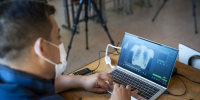WHO flags key challenges to global HIV response at International AIDS Conference

The World Health Organization is flagging 4 key challenges as the international community meets at the International AIDS Conference in Durban, South Africa, from 18–22 July 2016. The Organization is highlighting the need to renew attention to HIV prevention, whilst maintaining momentum on scaling up access to HIV treatment. It is also signalling the growing emergence of antiretroviral (ARV) drug resistance and the need for sustainable financing of the global response.
“The enormous progress on HIV, particularly on treatment, is one of the big public health success stories of the century,” says Dr Margaret Chan, Director-General, WHO. “But this is no time for complacency. If the world is to achieve its goal of ending AIDS by 2030, it must rapidly expand and intensify its efforts.”
Prevention
Globally, progress on HIV prevention has stalled. In 2015 there were 2.1 million new HIV infections – marginally fewer than the 2.2 million in 2010. In some regions, and among some groups, infections are rising. In some places where the epidemic had been under control, for example in some urban populations of men who have sex with men, it is re-emerging.
In 2014, 35% of new HIV infections worldwide occurred among men who have sex with men; sex workers and their clients; transgender people; people who inject drugs and people in prisons. In eastern and southern Africa, girls aged between 10–19 years remain particularly vulnerable and affected.
Reducing new HIV infections means addressing the social and legal barriers that impede many people from accessing HIV services. It means tailoring prevention programmes so the right services reach the groups that are most vulnerable and affected, ensuring that individuals have easy access to approaches that work, and work for them.
WHO notes that better prevention will happen if countries invest strategically in approaches with the greatest impact, for example by exploiting new interventions, such as pre-exposure prophylaxis (PrEP) – where antiretroviral drugs are used to protect people at high risk of becoming infected with HIV.
WHO also highlights the importance of revitalizing long-established and proven approaches, such as the promotion of condoms, and to maintain momentum on voluntary medical male circumcision in the 14 most-affected countries of eastern and southern African countries, where 11.7 million voluntary medical male circumcisions were performed by the end of 2015.
At the same time, countries need to deliver these services more efficiently to reach more people at lower cost, including through the integration of HIV prevention into sexual and reproductive health services.
Treatment
Since 2015, WHO has recommended that all people diagnosed with HIV start antiretroviral therapy (ART) as soon as possible to prevent illness and death. The uptake of WHO’s Treat All policy has been rapid. Implementation has been facilitated by recent dramatic improvements in ART being used – with 1 tablet a day which is safe and well tolerated.
Treatment saves lives: AIDS-related deaths have fallen 45% since their peak in 2005 and 26% since 2010. Expanding HIV treatment also helps reduce transmission: as the level of the virus drops in a person, so does the risk of transmission.
But many challenges remain. More than 40% of people living with HIV still do not know they are infected, highlighting the need for ready access to simple and affordable testing services. Self-testing provides an opportunity for more people to be tested, particularly those who are reluctant to use health services.
There is also a need to tailor treatment programmes to reach people who may be reluctant to come forward, and to ensure that these people are supported by a full range of community services, as well as strengthening health systems more generally so people can receive the full range of health services they need, beyond HIV.
Drug resistance
WHO’s last report on HIV-related drug resistance (2004-2008) showed that 5% of people on ART were resistant to at least 1 antiretroviral drug. The Organization is monitoring the trends and notes worrisome indications that drug resistance is emerging as a more significant threat in some countries and populations.
WHO is therefore launching a report on “Early Warning Indicators of HIV drug resistance” in Durban this week to help countries monitor factors that may contribute to the problem. These programme factors include adherence to treatment and retention in the services, interruptions in the supply of antiretroviral drugs through stock-outs, and poor quality of treatment services.
The report outlines actions countries need to take in order to identify problems early and to act quickly to avert drug resistance. As treatment continues to expand, countries will need to be vigilant to ensure that the quality of treatment services is assured to minimize the emergence of drug resistance. To address this threat, WHO is developing a Global Action Plan on HIV drug resistance – calling on countries to continue surveillance to ensure rapid action.
Financing for a sustainable response
The ever-expanding development agenda, changing donor priorities and continuing threats to the global economy all pose challenges to financing efforts to end AIDS. It will be important to ensure full replenishment of the Global Fund to fight AIDS, TB and Malaria in September.
Middle-income countries will face particular challenges as they transition from external to predominantly domestic funding of their HIV and broader health services.
At the same time, countries will need to align HIV responses with broader efforts towards universal health coverage and access to social protection. This will require them to generate more funds for health in general, for example through general taxation, and to establish robust financing mechanisms that enable individuals to receive the services they need without suffering financial hardship.
It will also be key to improve cost-effectiveness and increase efficiencies. Working to bring down the cost of medicines and other commodities is one way to do this. Another is closer integration of HIV services with the wider health system, and making the most of common health system platforms, such as strategic information, human resources, and procurement and supply management.



